
Highlights of the 1999 Excavations
Stockport Metropolitan Borough Council recognised the importance of the site to the heritage of the area and agreed to support the excavation with a grant which has generaously continued each year. A continuing programme of resistivity, magnetometry and ground-penetrating radarwas embarked upon, which has been essential to the investigation. Donald King and Roy King carried out tomographic resistivity surveys


In 1998 we had confirmed the presence of a large fortified, ditched enclosure, similar in style and size to neighbouring Iron Age Hillforts in Derbyshire. A single sherd of Iron Age pottery but plenty of typical fire cracked pebbles supported this. Artifacts in the upper fills of the ditch suggested that the site was still occupied during the Roman period.
Ten trenches were excavated in 1999 to confirm this, nine positioned where the ditch was thought to surround the site and one placed within the enclosure over an anomalous feature detected by Geophysics. Graham Eyre-Morgan from the University of Manchester continued to direct the excavations in 1999 with support from Stuart Holden.
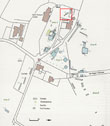
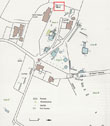
A third quadrant was added to the ditch (TX3 and TX4 became Trench1), which was taken down to rock at the bottom. This yielded many more artefacts, most surprising of which were Flints thought to be from the Mesolithic Period. Trench 2 in the corner of the garden near the West end of the Church exposed a possible palisade slot cut into the bedrock behind the ditch.
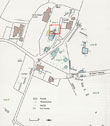
The long Trench 3 was opened in the middle of the garden over the anomalous feature identified by Geophysics. It revealed a large posthole with Mesolithic flints, Iron Age Pottery and Roman Pottery and was therefore extended into a large open area excavation.
This turned out to be very difficult archaeology, a complex series of stratified layers with intersecting features dating right through from the Mesolithic to the Romano British periods.
This turned out to be very difficult archaeology, a complex series of stratified layers with intersecting features dating right through from the Mesolithic to the Romano British periods.
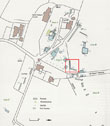
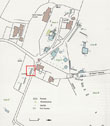 Trench 4 and Trench 5 were unsuccessful attempts to locate the edges of the ditch in the SE cormer of the field and the Church Car park, reaching Bedrock with no archaeological finds.
Trench 4 and Trench 5 were unsuccessful attempts to locate the edges of the ditch in the SE cormer of the field and the Church Car park, reaching Bedrock with no archaeological finds. Trench 6 and Trench 10 however, confirmed the line of the ditch to the North, revealing that the fortified enclosure could well have been much larger than previously anticipated, possibly up to an area of 15 or 16 acres, making it comparable to the largest Derbyshire Hillfort discovered so far at Mam Tor.
Trench 6 and Trench 10 however, confirmed the line of the ditch to the North, revealing that the fortified enclosure could well have been much larger than previously anticipated, possibly up to an area of 15 or 16 acres, making it comparable to the largest Derbyshire Hillfort discovered so far at Mam Tor.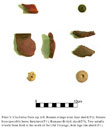 Artefacts discovered in 1999 included:
Artefacts discovered in 1999 included:A number of high quality Iron Age Pottery sherds, possible late Bronze Age flints, a bronze boss (possibly a piece of horse furniture)and most surprisingly an assemblage of Mesolithic flint work.
and a moderate amount of Late Medieval pottery.

The Friends of the Mellor Archaeological Trust was set up and the first Open Days were held on the first Saturday and Sunday of September. Finds from the site were put on display in the new Parish Centre, before being housed in the Museum at Stockport.
Read the full 1999 UMAU Archaeological Report
